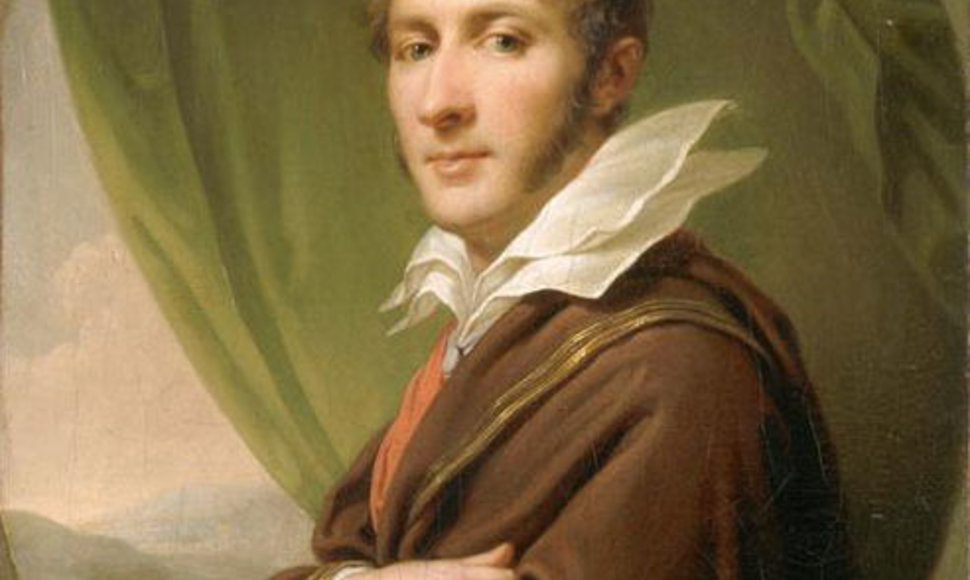There are some 300 items in the exhibition, which includes 72 portraits of the Sapieha family and other paintings, as well as a Brussels-made wall textile on religious themes, jewelry, arms and other antiques from the 16th-19th centuries that used to be owned by the Sapiehas. The items were brought from nine museums and another five cultural institutions in Lithuania and four museums in Poland. The main organizers of the exhibition are the Palace of Lithuanian Grand Dukes in Vilnius and the Wawel Palace of Polish Kings in Krakow. The trilingual catalogue book of the exhibition, available in Lithuanian, English and Polish, can be purchased at the Vilnius Picture Gallery for 167 litas (48 euros).
The 81-year-old Duke Michel Sapieha (or Mykolas Sapiega in the Lithuanian traditional transcription), who lives in Belgium now, arrived with his wife, son and sister to open the exhibition. It is the first visit by the Sapiehas to Lithuania in some 200 years. The Sapiehas left Lithuania for Austria when Lithuania was occupied by Russia at the end of 18th century. The modern-day Sapiehas said that they enjoyed Lithuania and they will come back next summer. The Sapiehas’ legacy is still alive in Lithuania: a forest near Vilnius is called Sapieginė and one of the hospitals in Vilnius, situated in one of the former palaces of Sapiehas, bears their name.
The exhibition was opened on 16 February, the national holiday that is officially called the Day of Re-establishment of the Lithuanian State. Indeed, in 1918 in Vilnius, all 20 members of the Lithuanian Council signed Lithuania’s independence declaration which emphasized the “re-establishment” of the state with its capital in Vilnius and the abolishment of all former alliances with other countries. “I leave to historians to evaluate the Republic of Both Nations. However, its heritage can be the pride for both Lithuanians and Poles,” Duke Sapieha said at the exhibition’s opening ceremony.
This family of Eastern Slavonic origin from the borderland of the Lithuanian empire and Russia started its rise in the 15th century. Later they avoided mentioning that origin - they became Catholics in order to enter Lithuania’s top political elite.
The Republic of Both Nations is the official name for the confederation of Poland and Lithuania (1569-1795). According to the confederation act of 1569, Lithuania and Poland agreed to have a common foreign policy and a common parliament where each MP had the right of veto. The financial, legal, and military systems remained separate. According to the act, Lithuania passed modern day Ukrainian lands to Poland while modern day Latvian and Estonian lands, which until then were the protectorate of Lithuania, became a condominium of Lithuania and Poland, though it was the Lithuanian army which continued to play the main role in battles against other powers in these northern territories after 1569.
The exhibition is titled “The Crosses stand for virtue, the Arrow for victory… The Sapiehas – statesmen, art patrons and collectors.” Over the course of 400 years, the Sapiehas played an important role in the history of the Grand Duchy of Lithuania. Many of them were Lithuania’s chancellors (the equivalent of Prime Ministers), senators, Lithuanian army generals and Catholic bishops. This family of Eastern Slavonic origin from the borderland of the Lithuanian empire and Russia started its rise in the 15th century. Later they avoided mentioning that origin - they became Catholics in order to enter Lithuania’s top political elite and the Sapiehas’ official genealogical tree portrayed their roots in the nobility of the Roman Empire via the dynasty of Lithuanian pre-Christian ruler Gediminas, which was in fashion among Lithuanian top nobility at the time.
During the creation of this exhibition, one interesting finding was made. A portrait of one of the Sapiehas who lived in the 18th–19th centuries, painted by Austrian Johann Baptist Lampi and now owned by the Sacral Art Center of the Lithuanian town of Anykščiai, has an identical copy by Lampi which is on show in the Louvre Museum in Paris. It was quite common for painters of that epoch to make several copies of portraits of aristocrats, which enabled aristocrats to hang the same portraits in several of their numerous estates.
“Due to such heritage, French Culture Minister Frederic Mitterrand told me that Lithuania has been established in Europe since ancient times,” Lithuanian Culture Minister Arūnas Gelūnas said about the exhibition.
In the summertime, an exhibition on the legacy of Radvila (or Radziwill) family (its most prominent members were sceptical about the confederation act of 1569, and in 1655 even signed the short-lived Lithuania’s confederation act with Sweden), which was the most influential family of the Grand Duchy of Lithuania, will be opened in the Radvilas Palace on 24 Vilniaus St. in Vilnius. An exhibition on the lifestyle of those who were above all these families, i.e. Lithuanian grand dukes, is already on show in the Museum of Applied Art on 3A Arsenalo St. in Vilnius.
The exhibition on the Sapiehas’ heritage is open until May 20. The Vilnius Picture Gallery is opened on Tuesdays-Saturdays from 11:00 to 18:00 and on Sundays from 11:00 to 17:00.
Closed on Mondays.












